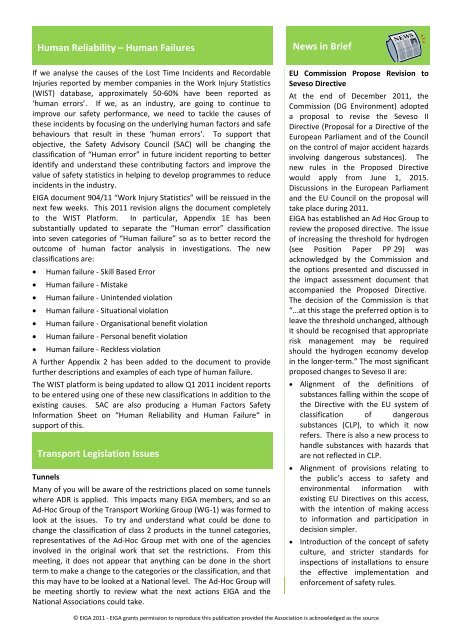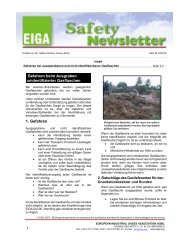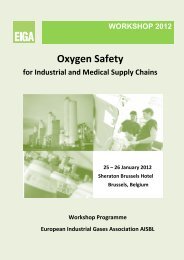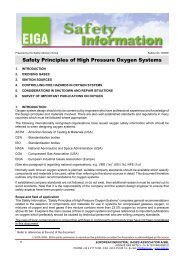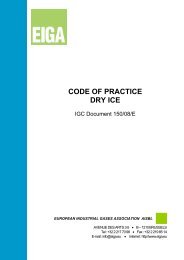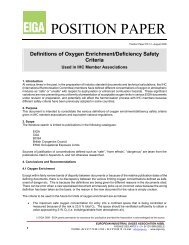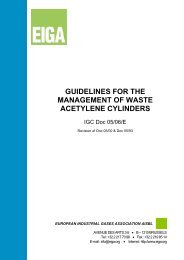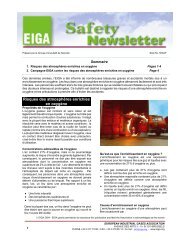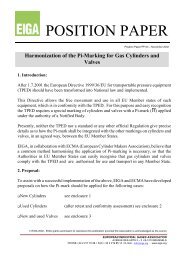downloaded - eiga
downloaded - eiga
downloaded - eiga
You also want an ePaper? Increase the reach of your titles
YUMPU automatically turns print PDFs into web optimized ePapers that Google loves.
Human Reliability – Human Failures<br />
If we analyse the causes of the Lost Time Incidents and Recordable<br />
Injuries reported by member companies in the Work Injury Statistics<br />
(WIST) database, approximately 50‐60% have been reported as<br />
‘human errors’. If we, as an industry, are going to continue to<br />
improve our safety performance, we need to tackle the causes of<br />
these incidents by focusing on the underlying human factors and safe<br />
behaviours that result in these ‘human errors’. To support that<br />
objective, the Safety Advisory Council (SAC) will be changing the<br />
classification of “Human error” in future incident reporting to better<br />
identify and understand these contributing factors and improve the<br />
value of safety statistics in helping to develop programmes to reduce<br />
incidents in the industry.<br />
EIGA document 904/11 “Work Injury Statistics” will be reissued in the<br />
next few weeks. This 2011 revision aligns the document completely<br />
to the WIST Platform. In particular, Appendix 1E has been<br />
substantially updated to separate the “Human error” classification<br />
into seven categories of “Human failure” so as to better record the<br />
outcome of human factor analysis in investigations. The new<br />
classifications are:<br />
� Human failure ‐ Skill Based Error<br />
� Human failure ‐ Mistake<br />
� Human failure ‐ Unintended violation<br />
� Human failure ‐ Situational violation<br />
� Human failure ‐ Organisational benefit violation<br />
� Human failure ‐ Personal benefit violation<br />
� Human failure ‐ Reckless violation<br />
A further Appendix 2 has been added to the document to provide<br />
further descriptions and examples of each type of human failure.<br />
The WIST platform is being updated to allow Q1 2011 incident reports<br />
to be entered using one of these new classifications in addition to the<br />
existing causes. SAC are also producing a Human Factors Safety<br />
Information Sheet on “Human Reliability and Human Failure“ in<br />
support of this.<br />
Transport Legislation Issues<br />
Tunnels<br />
Many of you will be aware of the restrictions placed on some tunnels<br />
where ADR is applied. This impacts many EIGA members, and so an<br />
Ad‐Hoc Group of the Transport Working Group (WG‐1) was formed to<br />
look at the issues. To try and understand what could be done to<br />
change the classification of class 2 products in the tunnel categories,<br />
representatives of the Ad‐Hoc Group met with one of the agencies<br />
involved in the original work that set the restrictions. From this<br />
meeting, it does not appear that anything can be done in the short<br />
term to make a change to the categories or the classification, and that<br />
this may have to be looked at a National level. The Ad‐Hoc Group will<br />
be meeting shortly to review what the next actions EIGA and the<br />
National Associations could take.<br />
News in Brief<br />
EU Commission Propose Revision to<br />
Seveso Directive<br />
At the end of December 2011, the<br />
Commission (DG Environment) adopted<br />
a proposal to revise the Seveso II<br />
Directive (Proposal for a Directive of the<br />
European Parliament and of the Council<br />
on the control of major accident hazards<br />
involving dangerous substances). The<br />
new rules in the Proposed Directive<br />
would apply from June 1, 2015.<br />
Discussions in the European Parliament<br />
and the EU Council on the proposal will<br />
take place during 2011.<br />
EIGA has established an Ad Hoc Group to<br />
review the proposed directive. The issue<br />
of increasing the threshold for hydrogen<br />
(see Position Paper PP‐29) was<br />
acknowledged by the Commission and<br />
the options presented and discussed in<br />
the impact assessment document that<br />
accompanied the Proposed Directive.<br />
The decision of the Commission is that<br />
“...at this stage the preferred option is to<br />
leave the threshold unchanged, although<br />
it should be recognised that appropriate<br />
risk management may be required<br />
should the hydrogen economy develop<br />
in the longer‐term.” The most significant<br />
proposed changes to Seveso II are:<br />
� Alignment of the definitions of<br />
substances falling within the scope of<br />
the Directive with the EU system of<br />
classification of dangerous<br />
substances (CLP), to which it now<br />
refers. There is also a new process to<br />
handle substances with hazards that<br />
are not reflected in CLP.<br />
� Alignment of provisions relating to<br />
the public’s access to safety and<br />
environmental information with<br />
existing EU Directives on this access,<br />
with the intention of making access<br />
to information and participation in<br />
decision simpler.<br />
� Introduction of the concept of safety<br />
culture, and stricter standards for<br />
inspections of installations to ensure<br />
the effective implementation and<br />
enforcement of safety rules.<br />
© EIGA 2011 ‐ EIGA grants permission to reproduce this publication provided the Association is acknowledged as the source


